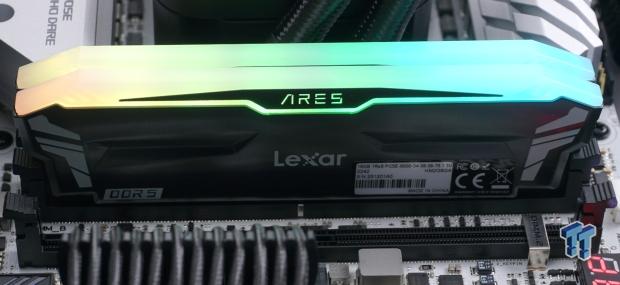The Bottom Line
Pros
- + Attractive styling
- + XMP 3.0 and EXPO compliant
- + Affordable
- + Known IC manufacturer
- + Lexar RGB Sync
Cons
- - Lexar RGB Sync
- - PMIC not cooled
- - Thermal tape overly adhesive
- - Performance
Should you buy it?
AvoidConsiderShortlistBuyIntroduction, Specifications, and Pricing
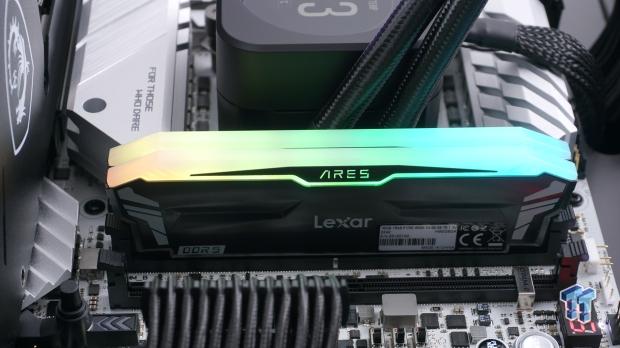
We knew it would not be long before the "universal" kits started to hit the market, and shockingly, the first set we got to look at was from someone we never expected. While we honestly had no idea Lexar was even in the gaming RAM game, here they are with the first to push a set of DDR5 with Intel XMP 3.0 and AMD EXPO compatibility. We have no opinion on what to expect from Lexar's new set of RAM, but we have thoughts on what we may see in this review.
The only issue with such a RAM kit is that you must play devil's advocate with every step of development and programming. Typically, with standard kits, you can finely tune things down and get the best of what the kit offers, whether intended for AMD or Intel systems. However, when you combine them, you cannot get the best of them, as you have to always consider what that following change will do to the other camp. While we expect to see good things from this set of DDR5, you may not want to get your hopes up too high, thinking that this will be the leader of its class.
Even though we do not expect miracles here, we will hold Lexar to the same standards with this entry to the lab as we would anyone else. Also, remember that this is a one-sided look at what the kit can do. We currently are not using an AMD system for RAM testing, mainly due to the artificial limitations that AMD seems to be keeping to with the last few generations of CPUs. Still, we digress and will look at what this ARES RGB from Lexar is capable of with our APEX, which is one of maybe three or four motherboards to give it its best shot at not only performance but overclocking as well, so we can see how well Lexar has done with their entry to the DDR5 game.

Lexar has gone all out with their ARES RGB, and while there are a few models to pick from, we have the LD5FU016G-R6000GDGA set. These DDR5 UDIMM sticks are covered in brushed metal heat spreaders which are dark gray. Each stick in this set is 16GB in density and boasts a speed of 6000MHz, good for AMD but not so fast for Intel. Attempting to close that gap, we find that the timings are aggressive. At 34-38-38-76 2T, it is one of the only CAS 34 kits on the market at this speed.
Lexar can keep the voltage down to 1.30V for this DDR5, where we'd expect 1.35V or 1.40V with the timings set for this product. Measurements show that Lexar does not go crazy with the heat spreaders like some others, keeping the length to 140mm, the height to 43.3mm, and the width at 7.9mm. All told, each stick comes in at 49 grams, which is a fair amount of aluminum to help keep these ICs cool under harsh operating conditions. Also, Lexar covers these kits with a limited lifetime warranty should anything go wrong.
Even though the product listing has a current snafu, we will try to help you through it. If you are to look for "Lexar DDR5" on Amazon.com, you will find a set of DDR4 with links to other kits. When you select the 6000MHz set of DDR5, you are taken to a page with the ASIN of B099GXKWLZ, sold by Chemical Guys as a leather conditioner. We then looked back at the emails from Lexar and found the ASIN they provided to see it is B0BXH3CMJK. Both ASIN numbers will get you to the intended product, and the pricing shown on these pages is correct.
At $149.99 is where Lexar started, and on its face, we have to say we get it, but it is one of the more expensive solutions in its category. The real questions are, do users want RAM they can swap between systems? Or, should Lexar have just stuck to one camp, not spent all that time on R&D, and sold us more affordable solutions over two different skews?
Packaging and Lexar ARES RGB
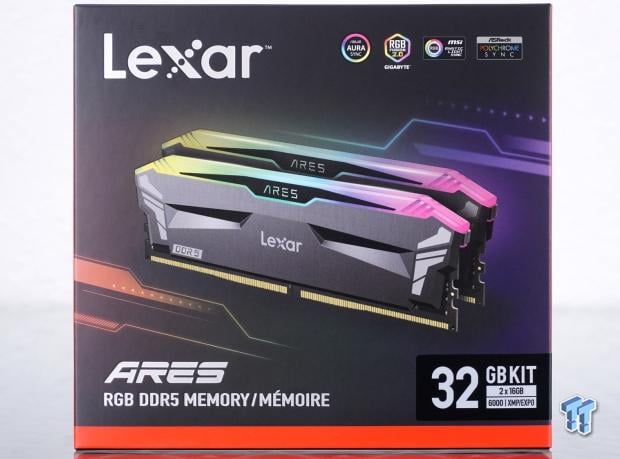
Packaging for the Lexar ARES RGB is attractive and will grab your attention on a store shelf, especially with that bright red stripe at the bottom. The bulk of the front panel is used for the image of the kit in the center, with some graphics that mimic the style of the spreaders. At the top, we see its sync compatibility; at the bottom, we see the density, speed, and XMP /EXPO compatibility.
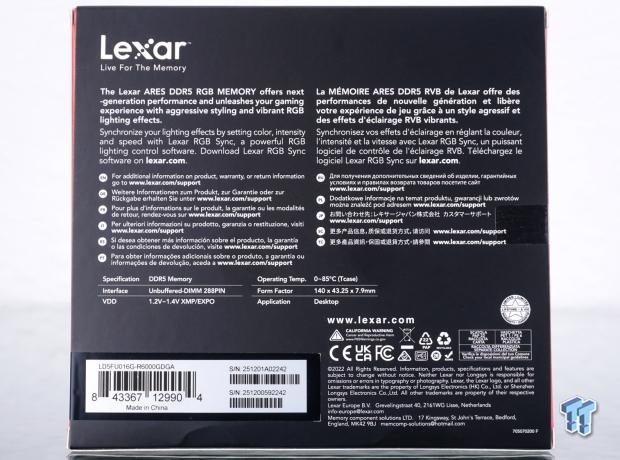
On the back, there are no cutouts to see the kits inside, but rather some words from Lexar about the aggressive styling, vibrant RGB effects, and that you can download Lexar RGB Sync, should your motherboard not offer sync. There is a condensed set of specifications near the bottom, where we see the product sticker with the model and serial numbers.
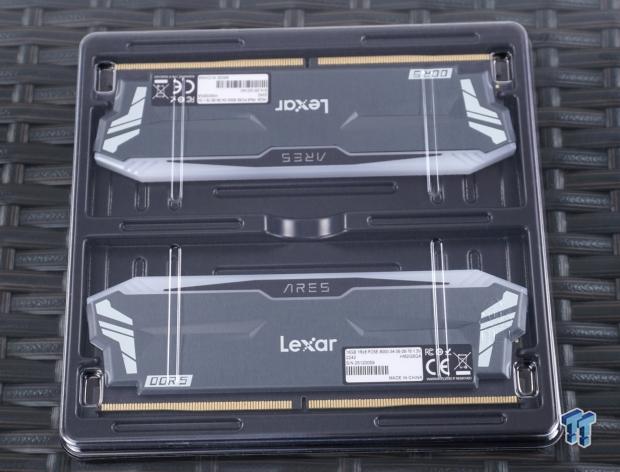
The Lexar ARES RGB is shipped in a higher-end inner packaging than most, more like the larger count trays where the bottom is black and thicker, and the top is more of a cover than a structural component. Lexar has also packaged the RAM light bar to light bar, which is atypical of how most RAM is packed.
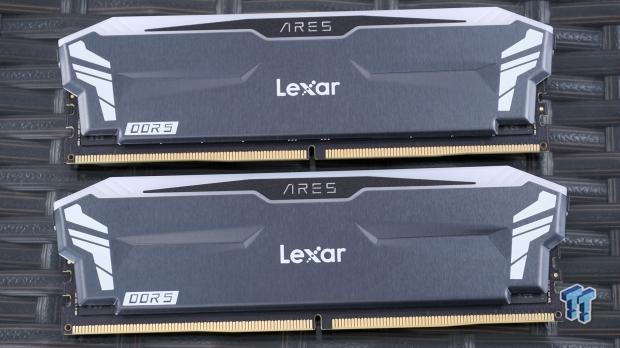
With nothing in our way, we can see the finer points of the head spreader design stuck atop the black PCBs. On both ends, painted graphics accompany the slits in the light bar, and the angles molded into the heat spreader. As mentioned, the spreaders are darker gray and brushed, but the white diffusers on top have black painted sections sporting the ARES name.
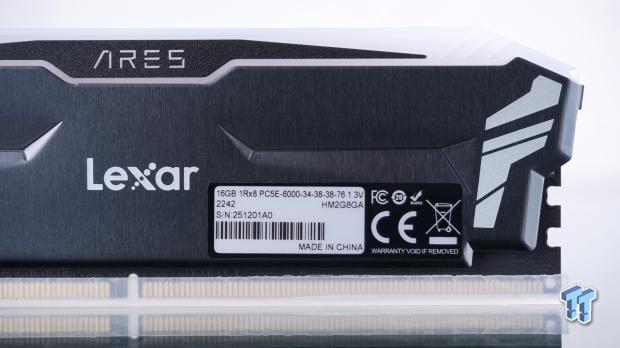
The other side of these sticks is identical to what we saw in the previous image, down to one detail. There isn't a sticker on the back, but on the front, or the side, you can see when installed, there is a product sticker. On it are the density of the stick, the rank, speed, timings, voltage, and serial number.
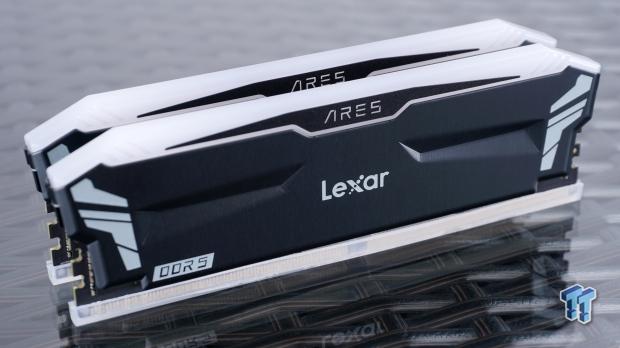
Similar to how you'd see these sticks installed, we see more from this angle. We can now see how deep the angles go into the heat spreaders on either side of the Lexar name. It is also much easier to see the small slits on the RGB diffusers near the ends.

Besides the angles at the end, the bulk of the diffusers are flat and plain. Lexar did not put their name here, and with the ARES name on the sides of the diffusers, Lexar allows the RGB LEDs to do all the talking at the top.
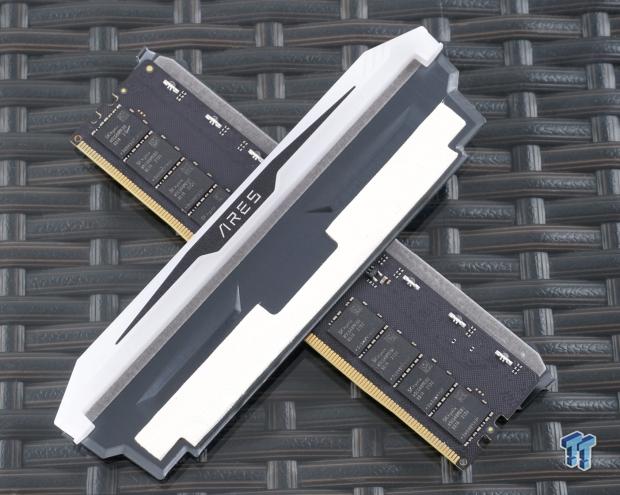
It took an extraordinary amount of force to remove these spreaders while they were warm, but we eventually won the battle so we could show you what lies under the hood. In this case, we have a set of eight SK Hynix H5CG48MEB0 or M-die ICs. On the back of the heat spreaders, we can see the extra sticky thermal tape used for the ICs, but the PMIC is left naked.
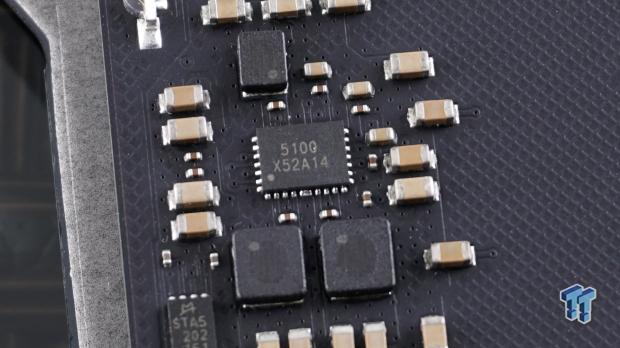
The PMIC of choice is what you see here. The 5100 X52A14 is new to us, and with the limited information available, we will not guess the manufacturer, but we can tell you that it does not come back to any of the typical players we tend to see in the PMICs installed on most DDR5.
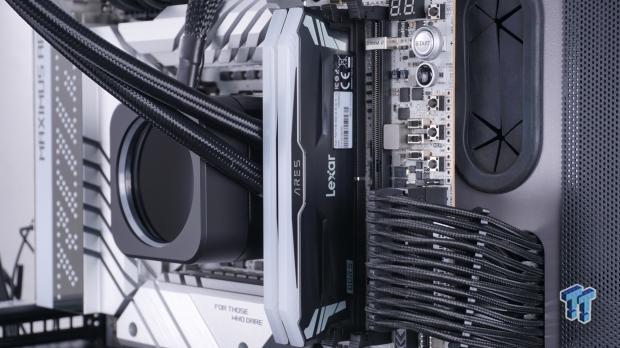
Installed, the ARES RGB fits perfectly to the system's theme with the dark heat spreaders and bits of white that match the APEX. Sadly, as we explained earlier, Lexar puts the stickers on the visible side of the sticks.
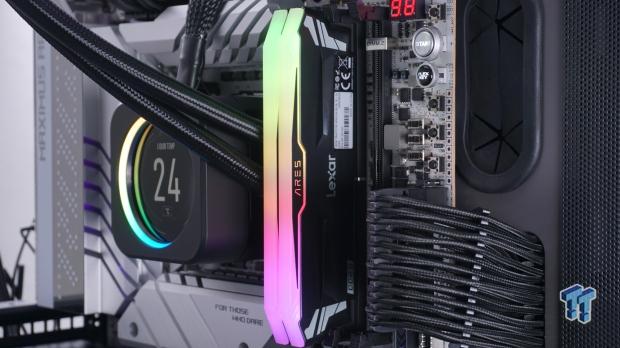
That sticker becomes less visible once the RGB display kicks in. The colors shift well from one to another, and in how they laid out these LEDs, there are no visible hotspots as we see from other manufacturers. We also like the black paint on the sides and how it makes the ARES name pop.
Test System Details
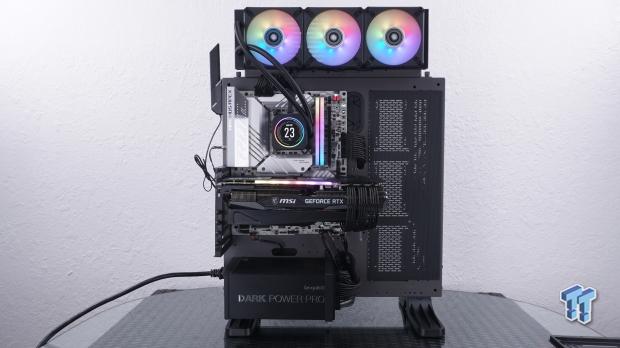
To obtain the Intel CPU-Z screenshots, you will see directly following this image, and this is the system we used to do it, as well as in attaining the results seen in the following pages. Thanks go out to be quiet!, ASUS, and NVIDIA, for supporting this venture. Detailed specifications of the system can be found below.
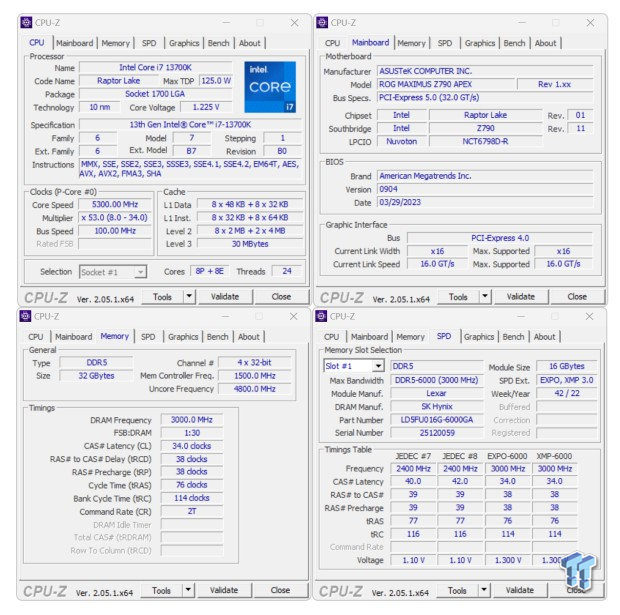
As they should, once all of the BIOS work is done, and XMP applied, our Lexar ARES RGB post as they say they should. The speed is set to 6000 MHz with 34-38-38-72 2T timings. Another trip back to the BIOS showed us that the VDIMM is set to 1.30V while our system agent used 0.865V and the memory controller used 1.119V.
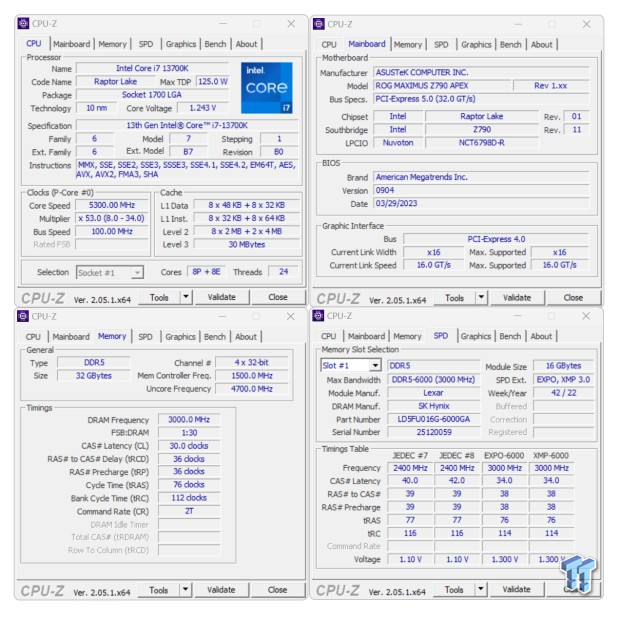
With a slight voltage adjustment, where the VDD, VDDq, and the Tx were set to 1.40V and raising the SA and MC volts a tenth, we played with the timings a bit. Ultimately, we landed with these ARES RGB running 6000MHz, but now with 30-36-36-76 2T timings.
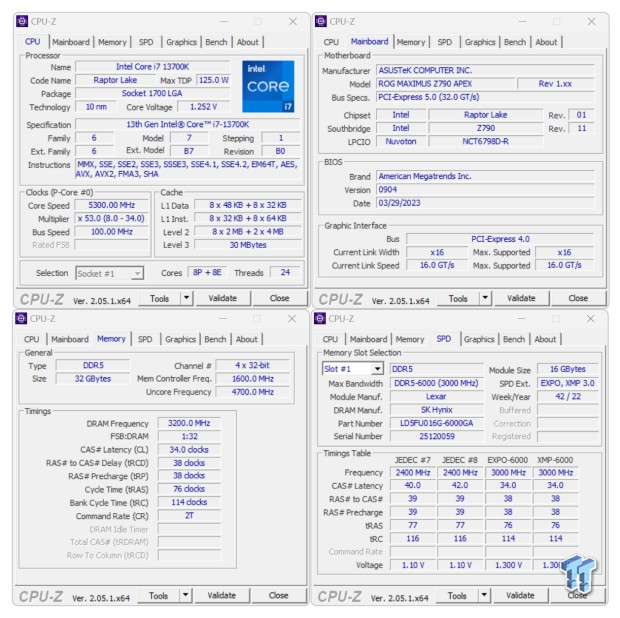
We kept the voltage as we had it for the previous runs and went for the maximum speed. On AMD systems, this may be too much for some, but we ended up at 6400 MHz. At CAS 34, this is a fair bump in speed, and we did not expect it to get this far.
Chad's Intel DDR5 Dual-Channel Test System Specifications
- Motherboard: ASUS Maximus Z690 APEX - Buy from Amazon
- CPU: Intel Core i9 12900K - Buy from Amazon
- Cooler: be quiet! PURE LOOP 360mm - Buy from Amazon
- Video Card: NVIDIA GeForce RTX 3070 Founders Edition - Buy from Amazon
- Storage: Phison B47R Fortis 1600 2TB M.2
- Case: Thermaltake Core P3 TG - Buy from Amazon
- Power Supply: be quiet! DARK POWER PRO 12 1200W - Buy from Amazon
- OS: Microsoft Windows 11 Home - Buy from Amazon
Intel Performance
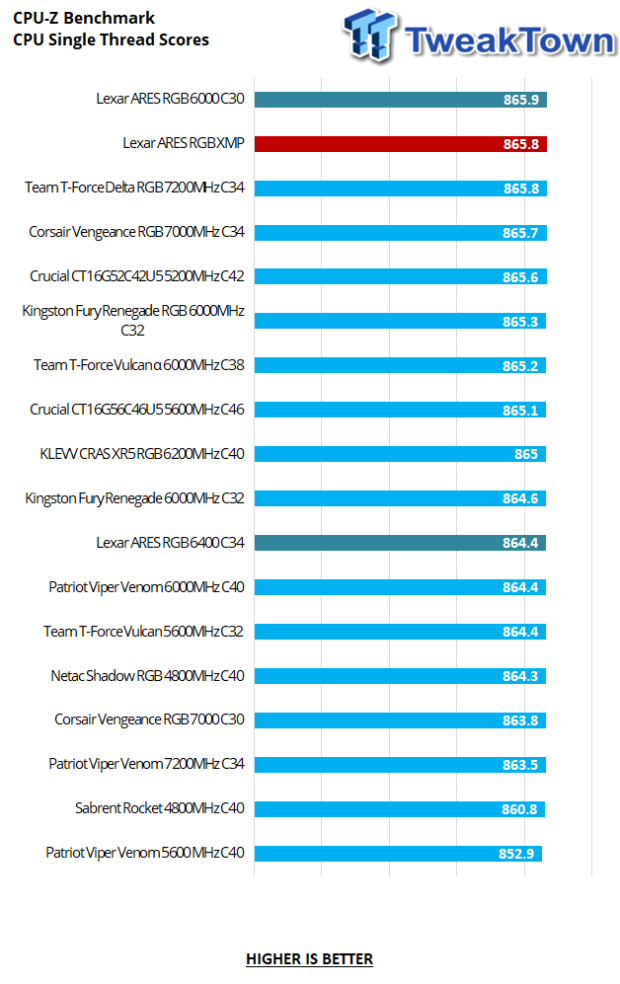
CPU-Z seems to love the ARES RGB, as it delivered the best XMP score on the chart. The CAS 30 run gives a slight advantage in this test, but at 6400 MHz, the performance was more midstream.
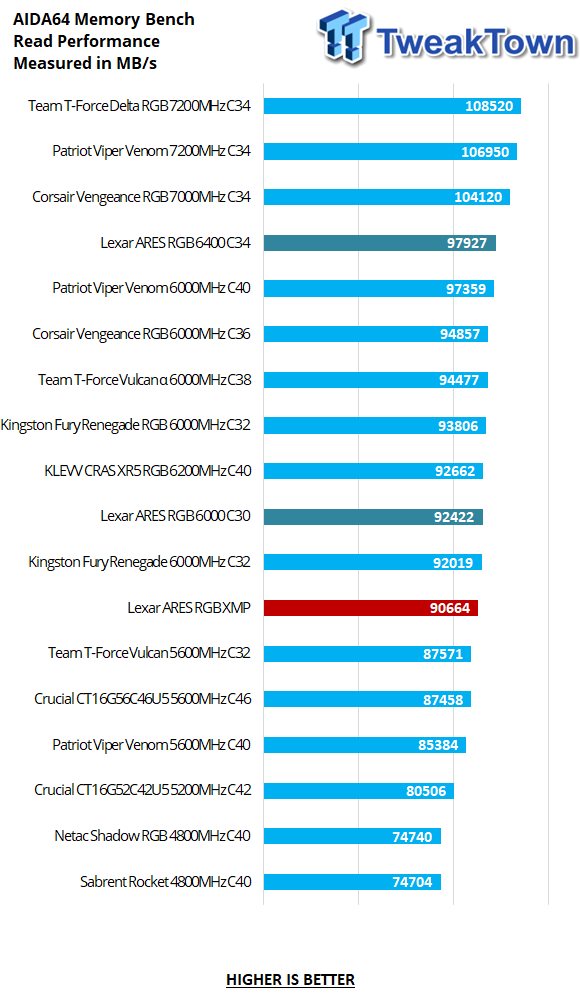
Read performance in AIDA64 isn't horrible starting at 90,664 MB/s, but it is the slowest of all 6000MHz submissions. We passed the FURY Renegade with reduced timings and got a 1758 MB/s boost. To beat all of the 6000 MHz submissions, the ARES had to be at 6400 MHz, which delivered us 7263 MB/s more than XMP.
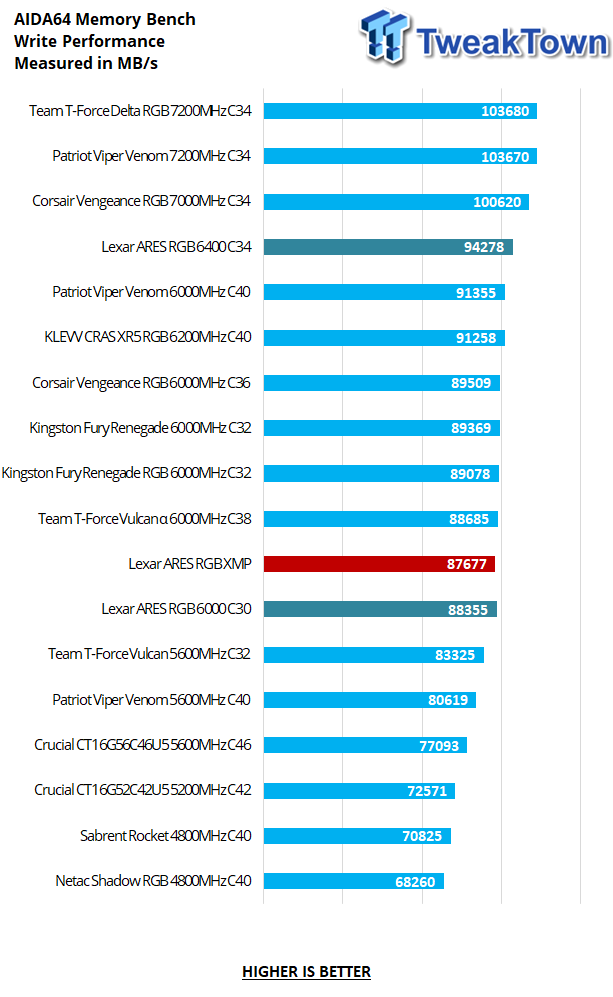
The ARES RGB is at the bottom of the 6000 MHz submissions again in write performance. Starting at 87,677 MB/s is slightly behind the Vulcan RAM, and while we misplaced the CAS 30 bar, we gained 678 MB/s, not lost them. Almost an exact repeat of the previous results, it takes 6400 MHz from the ARES to surpass the other 6000MHz kits. We love the 6601 MB/s advantage over XMP, but it takes much work to compete with the others in its class.
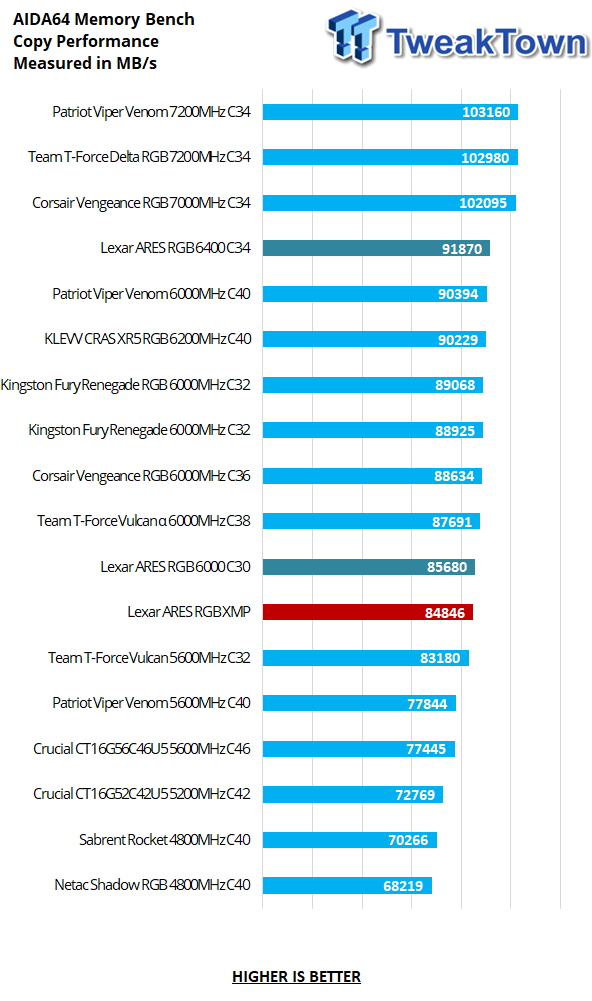
The Copy results show much of the same. Starting at 84,846, we see the chart's lowest 6000 MHz kit entry. Gaining 834 MB/s by reducing the timings is nice but does not improve the ARES placement. It again takes 400MHz more speed to cover the other entries in its class, although it did deliver a 7024 MB/s advantage using them this way versus XMP.
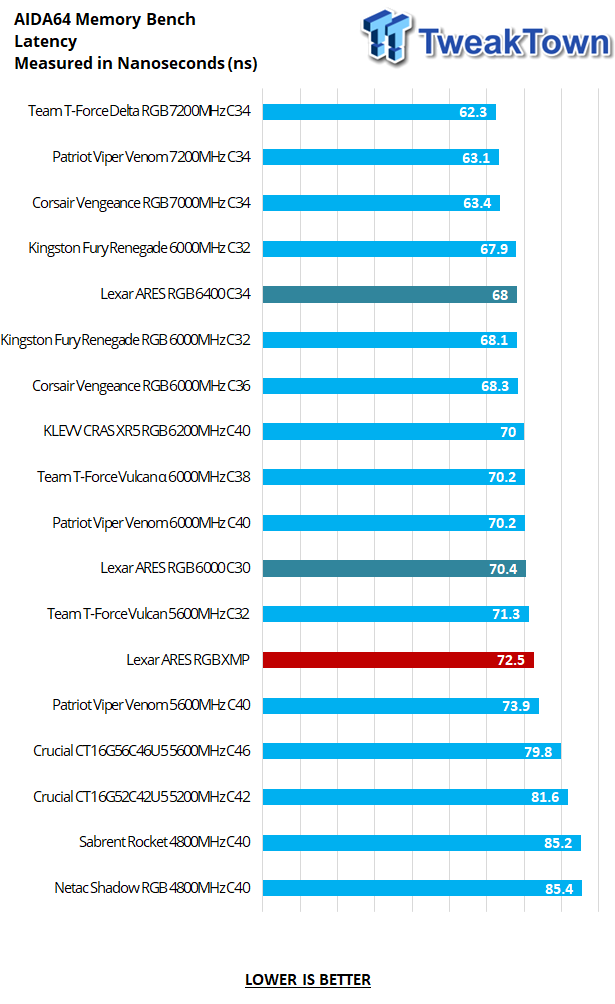
Latency is not great either, starting at 72.5ns, the highest of all the 6000 MHz entries. We got that latency down to 70.4 at CAS 30, but with more playing around, we got the latency down to 68 ns with increased speed.
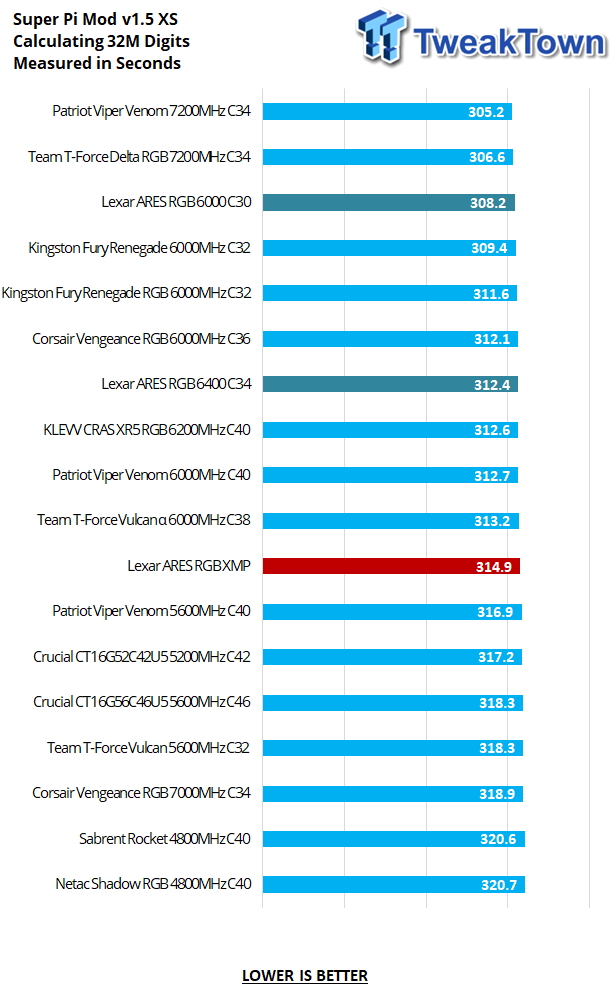
Super Pi feels similar to AIDA in the results. The XMP results are slower than other 6000 MHz combatants. Added speed helps a bit, running 2.5 seconds faster, but the lowered timings get near the top of the chart, reducing the completion time by 6.7 seconds.
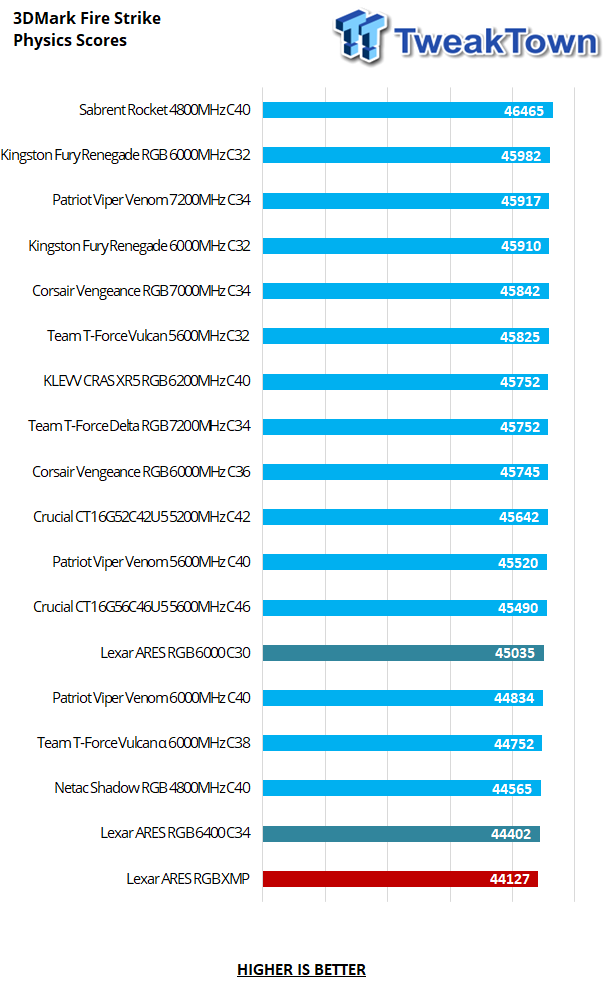
3DMark Fire Strike physics results show this is not the metric for the ARES RGB. With a last-place finish, there is nowhere to go but up, right? At least overclocking helps the ARES RGB scores but added speed gains little headway, where reduced timings benefit most.
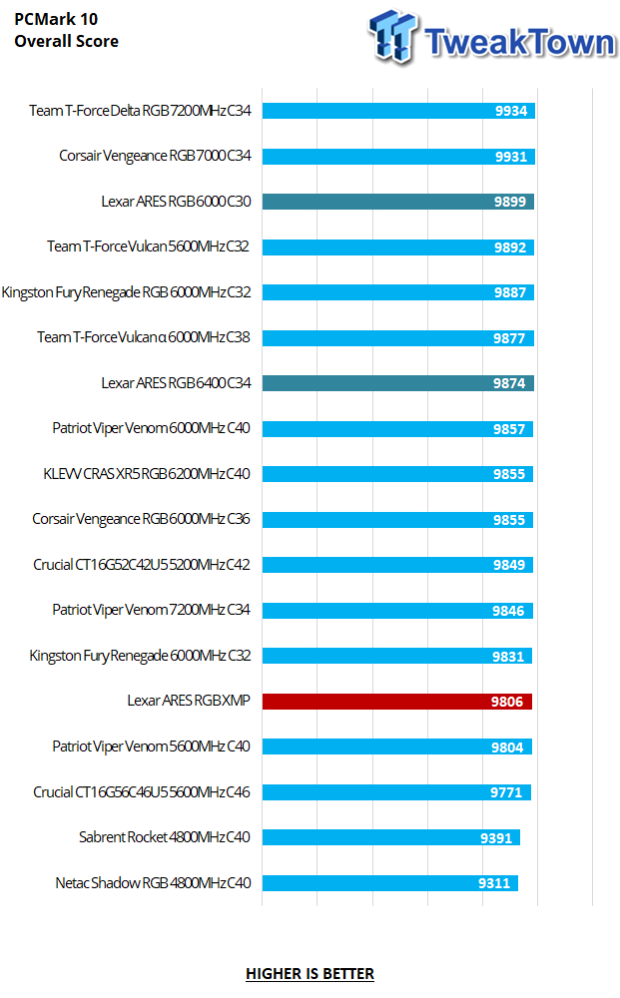
PCMark 10 is a bit more lenient on the ARES RGB but still has it at the bottom of the pile of 6000 MHz options. Added speed to the ARWES gave us a 60-ish pint advantage, but running them at CAS 30 gives us closer to 90 points over the XMP results.
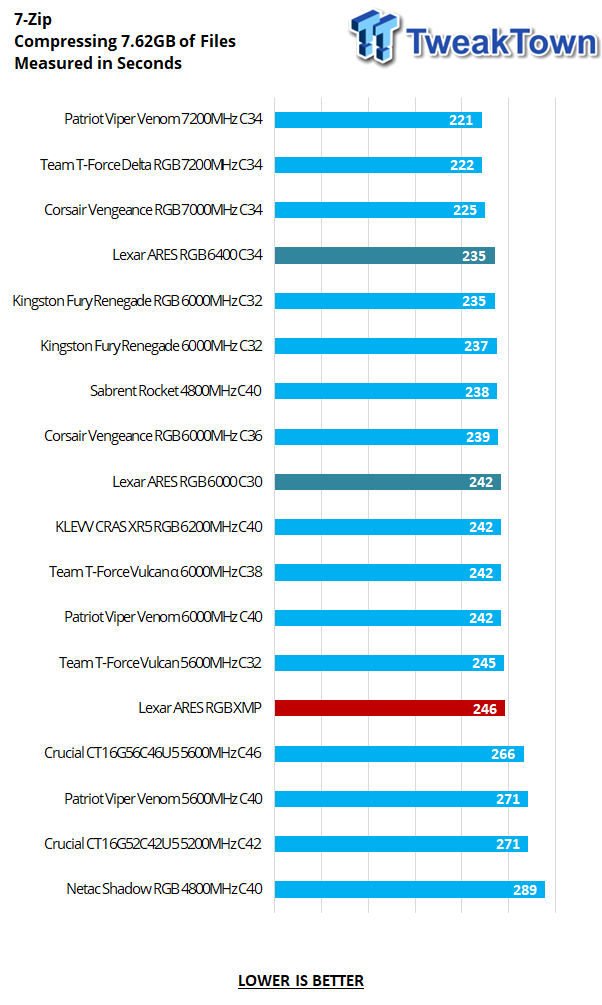
File compression with 7-Zip has played fair across all kits and sets them in almost perfect order by speed. However, the 5600 MHz Vulcan kit beat the Lexar ARES RGB with the 246-second result. We removed four seconds of run time with the CAS 30 setup but added speed dropped the time eleven seconds more and performed much better than expected.
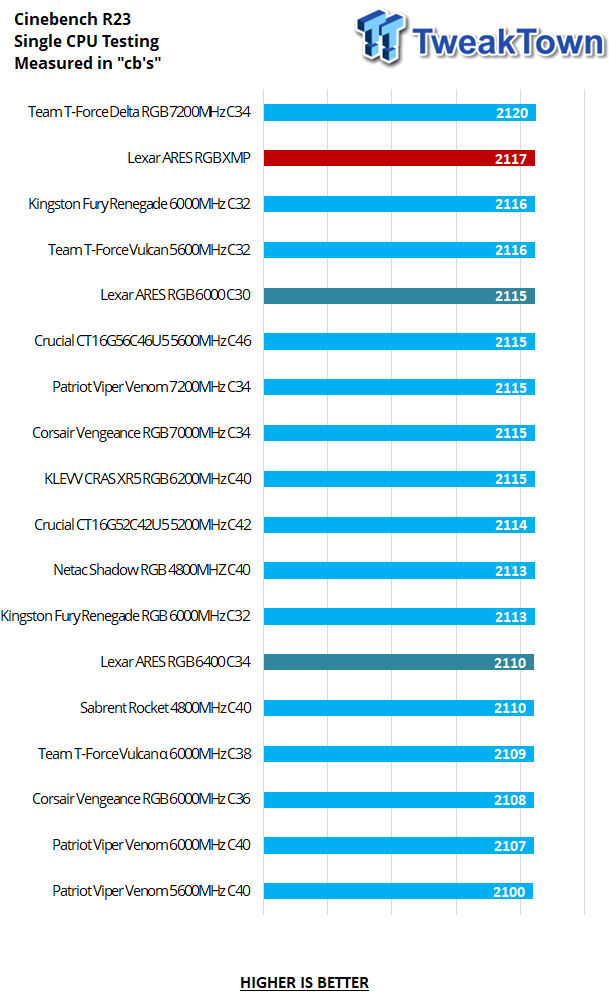
For those that want to run Cinebench R23 to impress their friends, the ARES RGB at XMP does extraordinarily well in this test. We honestly expected the overclocking options to add to that score, but both of those runs landed more in line with what could be expected of the speed and timings.
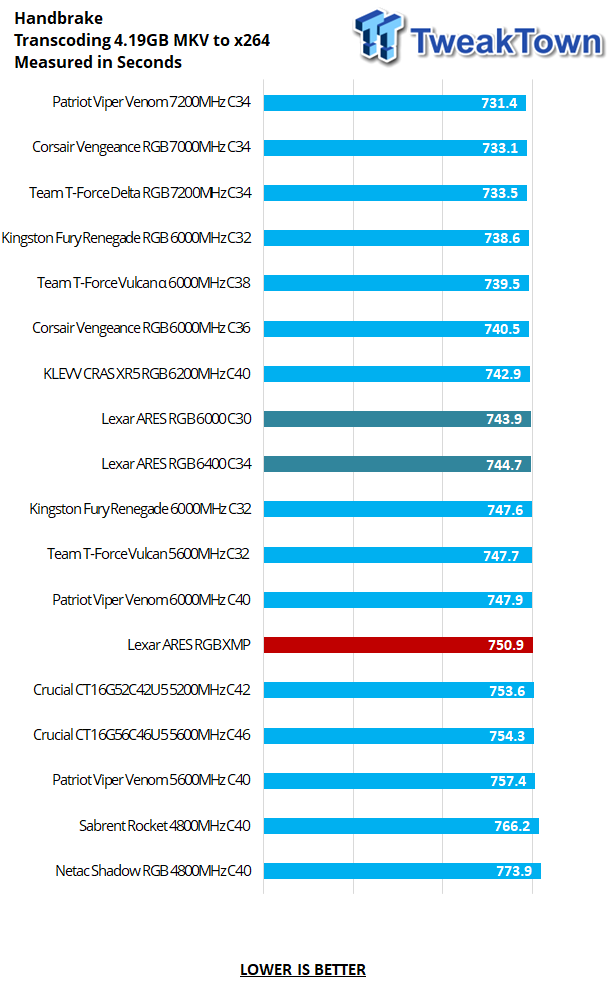
As we finally make it to transcoding, we again find the ARES RGB near the bottom of the chart. Still below all other 6000 MHz kits in the chart, and even while overclocked, we see Klevv, Corsair, TEAM, and Kingston with better options for our Intel system.
Final Thoughts
The packaging is attractive, we appreciate the unusual way the inner packaging is done, and we absolutely love the look of the ARES RGB. The gray is not new, but it is refreshing compared to all the black submissions we see. The styling is excellent and not too aggressive for most buyers, and adding in the brilliant RGB without hotspots is something even the more prominent names in DDR5 cannot get right.
Lexar opts for SK Hynix under the hood, which we can all get behind, but the lack of PMIC cooling is a bit of a downer. On the surface, this XMP/EXPO 6000MHz set of Lexar ARES RGB has everything you want, but we have yet to open the cover and get to the meat of the story.
While it is only one side of this two-sided coin, our Intel performance results were lackluster, almost across the board. There were oddities like CPU-Z and Cinebench, but the Lexar ARES RGB has trouble keeping up with its direct competition. We found the ARES RGB with lower results than the five other options we tested almost every time. Some of those may have been C 32 offerings, but at the same time, Lexar lost to the CAS 40 KLevv too. To us, this is much like a DDR2/3 or DDR3/4 motherboard.
Yes, it can run both, but it is not that good at running either of them, and with the results seen in this review, it is much the same. Our feelings up front ring valid, as with our Intel test system, it appears that things do not end well for Lexar and their ARES RGB.
On the topic of overclocking, we like that Lexar left some flexibility in the kit, as the charts needed those boosts in results for Lexar not to look like a failure across the board. While that may sound harsh, it is the reality, and if not for this ability, we would score the ARES RGB a fair bit lower than we are about to.
While we can see a niche spot in the market of users wanting RAM for both camps, say you have an older Intel setup and are thinking of AMD next, but a minor upgrade may help you get by for now. However, it feels like you may be on the wrong path. While it may make life easy for some, those buying RAM for performance reasons will likely be let down. Had Lexar just bit the bullet and made two skews, they could have launched a much better product.
Likely the biggest hurdle for the Lexar ARES RGB is the cost. At $149.99, they are not priced out of the market but are one of the more expensive options in the category. For something similar, in a head-to-head comparison, you can get RGB kits from G.Skill, Corsair, Patriot, v-color, and Kingston. While we may not have tested each model we refer to, the ones we tried came out on top compared to these Lexar ARES RGB sticks. Had these been in the realm of $109 or $119, Lexar would have a leg to stand on, but as it sits for our Intel builds, we cannot see many reasons to opt for this kit over the others.
To be fair, though, for the AMD users out there, we expect other reviews to be out there tested with the latest from AMD, and those may be much more favorable for Lexar. But with what we were given and what we have to test it with, we must go with what we can see.

